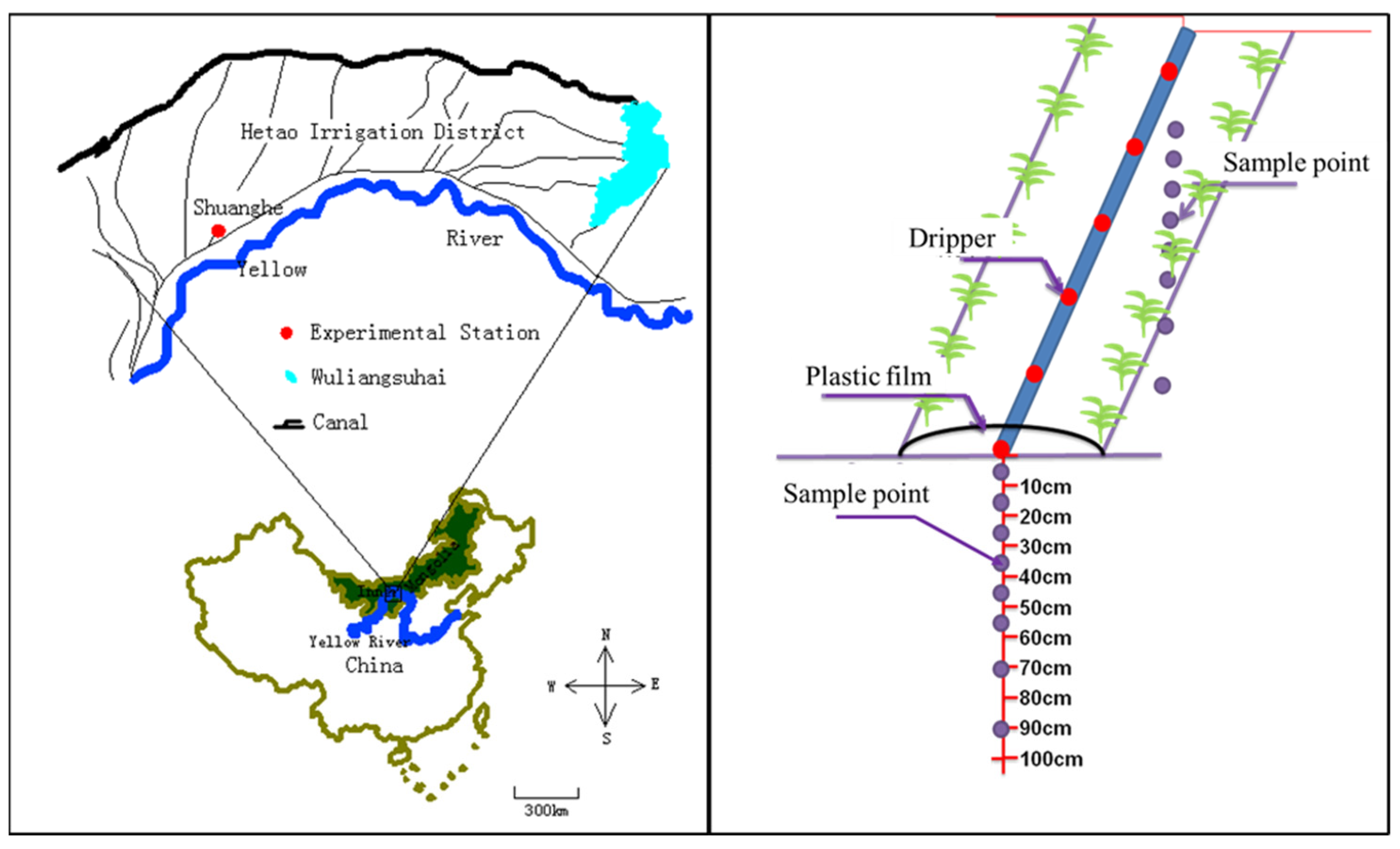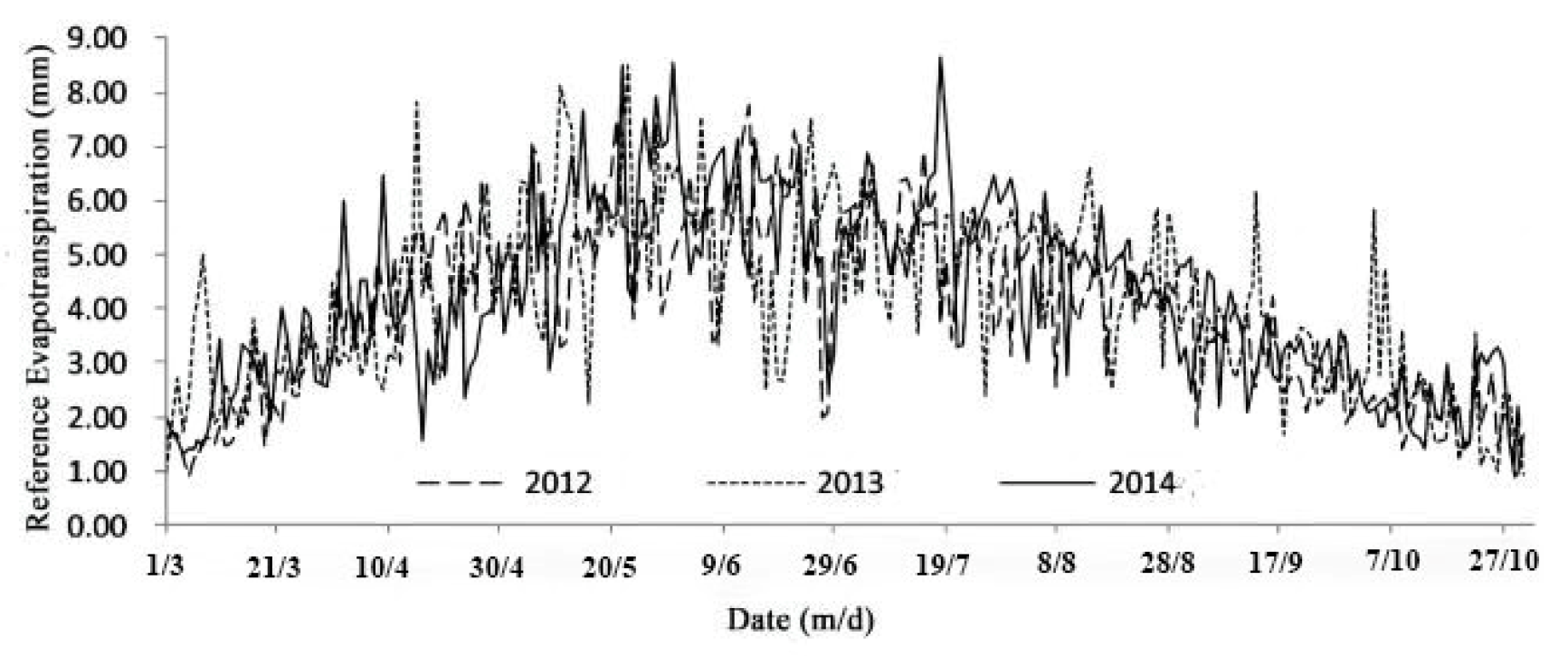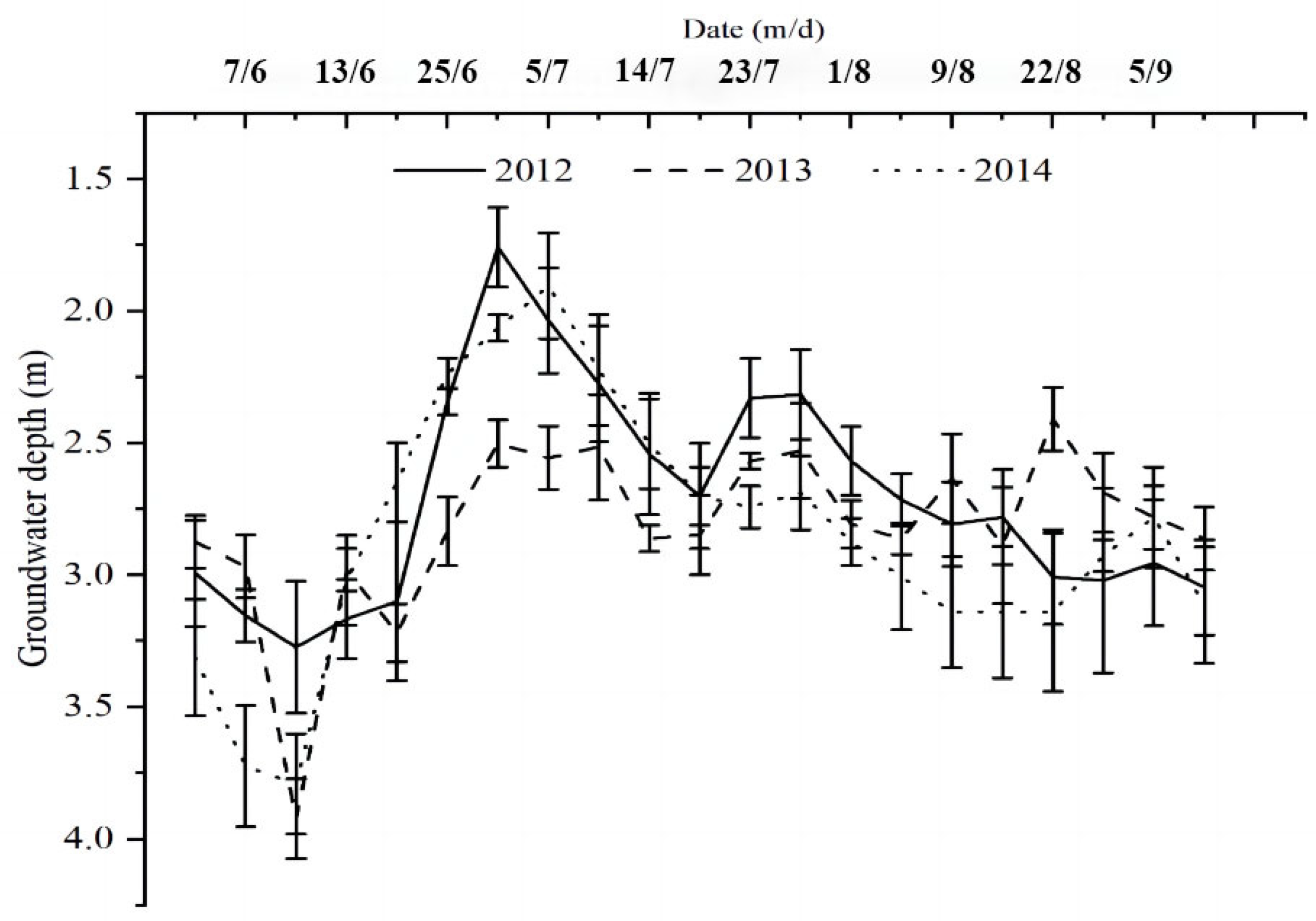Crop Coefficient of Sunflowers under Drip Irrigation with Plastic Film in Different Hydrological Years in the Hetao Irrigation District
Abstract
1. Introduction
2. Materials and Methods
2.1. Study Area
2.2. Experiment
2.2.1. Experimental Materials
2.2.2. Experimental Design
2.3. Measurements
2.3.1. Soil Physical and Chemical Properties
2.3.2. Meteorological Data and Groundwater
2.3.3. Crop Growth
2.4. Methods
2.4.1. Determination of Hydrological Year
2.4.2. Reference Crop Evapotranspiration
2.4.3. Actual Crop Evapotranspiration
2.4.4. Crop Coefficient
2.4.5. Data Analysis
3. Results and Discussions
3.1. Analysis of Hydrological Years and Representative Evaluation in Study Area
3.2. Crop Water Use for Drip Irrigation under Different Hydrological Annual Films
3.2.1. Reference Crop Evapotranspiration in Different Hydrological Years
3.2.2. Groundwater Changes and Groundwater Recharge during Crop Growth Period
3.2.3. Groundwater Recharge
3.2.4. Calculation of Annual Crop Evapotranspiration by Water Balance Method
3.3. Crop Coefficient in Different Hydrological Years
4. Conclusions
Author Contributions
Funding
Data Availability Statement
Acknowledgments
Conflicts of Interest
References
- Khouri, N.; Shideed, K.; Kherallah, M. Food security: Perspectives from the Arab World. Food Secur. 2011, 3, 1–6. [Google Scholar] [CrossRef]
- Meng, Z.J.; Gao, Y.; Yu, Y.; Ren, X.M. Crisis of Water Resources on the Ulan Buh Desert Oases, Inner Mongolia, China-A case of study of Dengkou county. J. Integr. Agric. 2013, 12, 1409–1413. [Google Scholar] [CrossRef]
- Jamshidi, S.; Zand-Paras, S.; Kamgar-Haghighi, A.A.; Shahsavar, A.R.; Niyogi, D. Evapotranspiration, crop coefficient, and physiological responses of citrus trees in semi-arid climate conditions. Agric. Water Manag. 2020, 227, 105838. [Google Scholar] [CrossRef]
- Kahlown, M.A.; Ashraf, M. Effect of shallow groundwater table on crop water requirements and crop yields. Agric. Water Manag. 2005, 76, 24–35. [Google Scholar] [CrossRef]
- Liu, Y.; Luo, Y. A consolidated evaluation of the FAO-56 dual crop coefficient approach using the lysimeter data in the North China Plain. Agric. Water Manag. 2010, 97, 31–40. [Google Scholar] [CrossRef]
- Gao, X.Y.; Huo, Z.L.; Bai, Y.N.; Feng, S.Y.; Huang, G.H.; Shi, H.B.; Qu, Z.Y. Soil salt and groundwater change in flood irrigation field and uncultivated land: A case study based on 4-year field observations. Environ. Earth Sci. 2015, 73, 2127–2139. [Google Scholar] [CrossRef]
- Huo, Z.L.; Feng, S.Y.; Huang, G.H.; Zheng, Y.Y.; Wang, Y.H.; Guo, P. Effect of groundwater level depth and irrigation amount on water fluxes at the groundwater table and water use of wheat. Irrig. Drain. 2012, 61, 348–356. [Google Scholar] [CrossRef]
- Chen, J.L.; Kang, S.Z.; Du, T.S.; Qiu, R.J.; Guo, P.; Chen, R.Q. Quantitative response of greenhouse tomato yield and quality to water deficit at different stages. Agric. Water Manag. 2013, 129, 152–162. [Google Scholar] [CrossRef]
- Babajimopoulos, C.; Panoras, A.; Georgoussis, H.; Arampatzis, G.; Hatzigiannakis, E.; Papamichail, D. Contribution to irrigation from shallow water table under field conditions. Agric. Water Manag. 2007, 92, 205–210. [Google Scholar] [CrossRef]
- Saadi, S.; Todorovic, M.; Tanasijevic, L.; Pereira, L.S.; Pizzigalli, C.; Lionello, P. Climate change and Mediterranean agriculture: Impacts on winter wheat and tomato crop evapotranspiration, irrigation requirements and yield. Agric. Water Manag. 2015, 147, 103–115. [Google Scholar] [CrossRef]
- Anderson, R.G.; Alfieri, J.G.; Tirado-Corbalá, R.; Gartung, J.; McKee, L.G.; Prueger, J.H.; Wang, D.; Ayars, J.E.; Kustas, W.P. Assessing FAO-56 dual crop coefficients using eddy covariance flux partitioning. Agric. Water Manag. 2017, 179, 92–102. [Google Scholar] [CrossRef]
- Nguyen, D.C.H.; Ascough, H.J.C.; Maier, H.R.; Dandy, G.C.; Andales, A.A. Optimization of irrigation scheduling using ant colony algorithms and an advanced cropping system model. Environ. Model. Softw. 2017, 97, 32–45. [Google Scholar] [CrossRef]
- Perea, R.G.; Poyato, E.C.; Montesinos, P.; Diaz, J.R. Optimization of irrigation scheduling using soil water balance and genetic algorithms. Water Resour. Manag. 2016, 30, 2815–2830. [Google Scholar] [CrossRef]
- De Medeiros, G.A.; Arruda, F.B.; Sakai, E. Crop coefficient for irrigated beans derived using three reference evaporation methods. Agric. For. Meteorol. 2005, 135, 135–143. [Google Scholar] [CrossRef]
- Er-Raki, S.; Chenbouni, A.; Hoedjes, J.; Ezzahar, J.; Duchemin, B.; Jacob, F. Improvement of FAO-56 method for olive orchards through sequential assimilation of thermal infrared-based estimates of E.T. Agric. Water Manag. 2008, 95, 309–321. [Google Scholar] [CrossRef]
- Gonzalez T., F.; Pavek, M.J.; Holden, Z.J.; Garza, R. Evaluating potato evapotranspiration and crop coefficients in the Columbia Basin of Washington state. Agric. Water Manag. 2023, 286, 108371. [Google Scholar] [CrossRef]
- Elis Marina de Freitas, Gustavo Henrique da Silva, Gabriel Fernandes Costa Guimarães, Thayne Nárgyle Botelho Vital, Joslanny Higino Vieira, Fernando Augusto da Silveira, Carlos Nick Gomes, Fernando França da Cunha, Evapotranspiration and crop coefficient of Physalis peruviana cultivated with recycled paper as mulch. Sci. Hortic. 2023, 320, 112212.
- Fernandez, J.Z.; Alcon, F.; Diaz-Espejo, A.; Hernandez-Santana, V.; Cuevas, M.V. Water productivity and economic analyses for super high density olive orchards. In Proceedings of the IX International Symposium on Irrigation of Horticultural Crops, Matera, Italy, 17–20 June 2019. [Google Scholar]
- Hou, X.H.; Fan, J.L.; Zhang, F.C.; Hu, W.H.; Yan, F.L.; Xiao, C.; Li, Y.P.; Cheng, H.L. Determining water use and crop coefficients of drip-irrigated cotton in south Xinjiang of China under various irrigation amounts. Ind. Crops Prod. 2022, 176, 114376. [Google Scholar] [CrossRef]
- Guo, H.; Li, S.E.; Kang, S.Z.; Du, T.S.; Tong, L.; Hao, X.M.; Ding, R.S. Crop coefficient for spring maize under plastic mulch based on 12-year eddy covariance observation in the arid region of Northwest China. J. Hydrol. 2020, 588, 125108. [Google Scholar] [CrossRef]
- Liu, B.; Han, H.H.; Liu, X.C.; Li, C.; Chen, X.P.; Wu, H.; Luo, Y.F.; Cui, Y.L. Quantifying the effects of advection on single crop coefficients over a humid paddy field for sustainable irrigation. J. Hydrol. 2022, 614, 128552. [Google Scholar] [CrossRef]
- Allen, R.; Pereira, L.; Raes, D.; Smith, M. Crop Evapotranspiration-Guidelines for computing crop water requirements. FAO Irrig. Drain. Pap. 1998, 56, 29–64. [Google Scholar]
- Mahohoma, W. Measurement and Modelling of Water Use of Citrus Orchards. Ph.D. Dissertation, University of Pretoria, Pretoria, South Africa, 2016. [Google Scholar]
- Muniandy, J.M.; Yusop, Z.; Askari, M. Evaluation of reference evapotranspiration models and determination of crop coefficient for Momordica charantia and Capsicum annuum. Agric. Water Manag. 2016, 169, 77–89. [Google Scholar] [CrossRef]
- Peddinti, S.R.; Kambhammettu, B.P. Dynamics of crop coefficients for citrus orchards of central India using water balance and eddy covariance flux partition techniques. Agric. Water Manag. 2019, 212, 68–77. [Google Scholar] [CrossRef]
- Zapata-Sierra, A.J.; Mpreno-Perez, M.F.; Reyes-Requena, R.; Manzano-Agugliaro, F. Root distribution with the use of drip irrigation on layered soils at greenhouses crops. Sci. Total Environ. 2021, 768, 144944. [Google Scholar] [CrossRef]
- Jafari, M.; Kamali, H.; Keshavarz, A.; Momeni, A. Estimation of evapotranspiration and crop coefficient of drip-irrigated orange trees under a semi-arid climate. Agric. Water Manag. 2021, 248, 106769. [Google Scholar] [CrossRef]
- Li, B.; Wim, V.; Shukla, M.K.; Du, T.S. Drip irrigation provides a trade -off between yield and nutritional quality of tomato in the solar greenhouse. Agric. Water Manag. 2021, 249, 106777. [Google Scholar] [CrossRef]
- Garrity, P.D.; Watts, D.G.; Sullivan, C.Y.; Gilley, J.R. Moisture deficits and grain sorghum performance: Evapotranspiration-yield relationships. Agron. J. 1982, 74, 815–820. [Google Scholar] [CrossRef]
- Shi, H.B.; Tian, J.C.; Liu, Q.H. Irrigation and Drainage Engineering; China Water Resources and Hydropower Press: Beijing, China, 2006. [Google Scholar]
- Li, F.H.; Fu, J.P.; Sun, X.F. Experimental study on groundwater utilization by crops. Groundwater 1992, 14, 197–202. [Google Scholar]
- Dai, J.X.; Shi, H.B.; Tian, D.L.; Xia, Y.H.; Li, M.H. Determined of crop coefficient of main grain and oil crops in Inner Mongolia Hetao Irrigation Area. J. Irrig. Drain. 2011, 30, 23–27. [Google Scholar]
- Jensen, M.E. Evapotranspiration and irrigation requirements. In ASCE Mannuals and Reports on Engineering Practice; Utah State University: Logan, UT, USA, 1990; Volume 332. [Google Scholar]
- Kang, S.Z.; Gu, B.J.; Du, T.S.; Zhang, J.H. Crop coefficient and ratio of transpiration to evapotranspiration of winter wheat and maize in a semi-humid region. Agric. Water Manag. 2003, 29, 239–254. [Google Scholar] [CrossRef]
- Gao, X.Y.; Bai, Y.N.; Huo, Z.L.; Huang, G.H.; Xia, Y.H.; Steenhuis, S.T. Deficit irrigation enhances contribution of shallow groundwater to crop water consumption in arid area. Agric. Water Manag. 2017, 185, 116–125. [Google Scholar] [CrossRef]
- Maestre-Valero, J.; Testi, J.; Jimenez-Bello, M.; Castel, J.R.; Intrigliolo, D.S. Evapotranspiration and carbon exchange in a citrus orchard using eddy covariance. Irrig. Sci. 2017, 35, 397–408. [Google Scholar] [CrossRef]
- Jia, Y.L. Effect of Biochar on Soil Water-Heat-Salt Transport and Corn Growth under Different Irrigation Methods; Inner Mongolia Agricultural University: Hohhot, China, 2020. [Google Scholar]
- Amayreh, J.; Al-Abed, N. Developing crop coefficients for field-grown tomato (Lycopersicon esculentum Mill.) under drip irrigation with black plastic mulch. Agric. Water Manag. 2005, 73, 247–254. [Google Scholar] [CrossRef]
- Yang, P.J.; Hu, H.C.; Tian, F.Q.; Zhang, Z.; Dai, C. Crop coefficient for cotton under plastic mulch and drip irrigation based on eddy covariance observation in an arid area of northwestern China. Agric. Water Manag. 2016, 171, 21–30. [Google Scholar] [CrossRef]
- Ding, Y.H.; Gao, X.Y.; Qu, Z.Y.; Jia, Y.L.; Hu, M.; Li, C.J. Effect of biochar application and irrigation methods on soil temperature in farmland. Water 2019, 11, 499. [Google Scholar] [CrossRef]






| Groundwater Recharge during the Sunflower Growth Period in 2012 (mm) | Groundwater Recharge during the Sunflower Growth Period in 2013 (mm) | |||||||
|---|---|---|---|---|---|---|---|---|
| Time | Early | Mid | Late | Month Total | Early | Mid | Late | Month Total |
| June | 6.88 | 6.88 | 1.02 | 0.00 | 3.46 | 4.48 | ||
| July | 9.38 | 6.82 | 18.80 | 34.99 | 8.31 | 7.49 | 18.79 | 34.59 |
| August | 10.03 | 6.33 | 2.09 | 18.45 | 10.29 | 9.07 | 5.51 | 24.86 |
| September | 2.87 | 0.85 | 1.81 | 5.52 | 2.40 | 0.41 | 0.00 | 2.81 |
| October | 1.63 | 1.63 | ||||||
| Total | 67.47 | 66.75 | ||||||
| Groundwater recharge during the sunflower growth period in 2014 (mm) | The 2014 effectiveness calculation of groundwater recharge using Equation (3) (mm) | |||||||
| Time | early | mid | late | Month total | early | mid | late | Month total |
| June | 0.50 | 1.09 | 6.57 | 8.16 | 0.95 | 2.93 | 10.1 | 13.98 |
| July | 10.91 | 8.02 | 8.95 | 27.88 | 8.89 | 10.20 | 7.20 | 26.29 |
| August | 1.53 | 0.00 | 1.35 | 2.87 | 1.30 | 0.30 | 0.90 | 2.50 |
| September | 2.96 | 0.38 | 0.36 | 3.70 | ||||
| October | ||||||||
| Total | 42.61 | 42.77 | ||||||
| Years | Seedling Stage | Squaring Stage | Flowering Stage | Filling Stage | Maturation Period | Total |
|---|---|---|---|---|---|---|
| 2012 | −0.61 (±0.1) | −8.26 (±0.4) | 7.06 (±0.2) | 13.23 (±2.1) | 0.40 (±0.1) | 11.82 (±1.2) |
| 2013 | −7.21 (±0.3) | 7.71 (±0.6) | −5.60 (±0.4) | −3.12 (±0.9) | 20.28 (±1.1) | 12.06 (±0.8) |
| 2014 | −3.28 (±0.4) | −0.46 (±0.1) | 27.77 (±1.5) | −33.50 (±2.2) | 4.48 (±0.8) | −5.00 (±1.0) |
| Parameter Name | Years | Seedling Stage | Squaring Stage | Flowering Stage | Filling Stage | Maturation Period | Total |
|---|---|---|---|---|---|---|---|
| ET0 (mm) | 2012 | 129.25 | 94.29 | 88.61 | 82.61 | 74.96 | 469.72 |
| 2013 | 179.17 | 125.28 | 105.41 | 66.26 | 89.27 | 565.39 | |
| 2014 | 145.48 | 96.01 | 120.37 | 92.81 | 85.99 | 540.66 | |
| ET (mm) | 2012 | 82.74 (±2.1) | 87.06 (±1.8) | 82.24 (±2.3) | 52.1 (±1.5) | 33.23 (±0.9) | 337 (±8.1) |
| 2013 | 98.83 (±1.2) | 98.97 (±3.6) | 87.55 (±1.6) | 33.16 (±0.1) | 33.44 (±1.1) | 350 (±6.9) | |
| 2014 | 66.94 (±4.0) | 65.38 (±1.5) | 94 (±2.8) | 52.16 (±0.3) | 35.3 (±0.4) | 312 (±7.1) | |
| Kc | 2012 | 0.64 (±0.016) | 0.92 (±0.019) | 0.93 (±0.026) | 0.63 (±0.018) | 0.44 (±0.012) | |
| 2013 | 0.55 (±0.007) | 0.78 (±0.029) | 0.84 (±0.015) | 0.51 (±0.002) | 0.37 (±0.012) | ||
| 2014 | 0.46 (±0.027) | 0.67 (±0.016) | 0.78 (±0.023) | 0.56 (±0.003) | 0.42 (±0.005) |
Disclaimer/Publisher’s Note: The statements, opinions and data contained in all publications are solely those of the individual author(s) and contributor(s) and not of MDPI and/or the editor(s). MDPI and/or the editor(s) disclaim responsibility for any injury to people or property resulting from any ideas, methods, instructions or products referred to in the content. |
© 2024 by the authors. Licensee MDPI, Basel, Switzerland. This article is an open access article distributed under the terms and conditions of the Creative Commons Attribution (CC BY) license (https://creativecommons.org/licenses/by/4.0/).
Share and Cite
Gao, X.; Tang, P.; Wang, Z.; Yao, Y.; Qu, Z.; Yang, W.; Du, B. Crop Coefficient of Sunflowers under Drip Irrigation with Plastic Film in Different Hydrological Years in the Hetao Irrigation District. Water 2024, 16, 235. https://doi.org/10.3390/w16020235
Gao X, Tang P, Wang Z, Yao Y, Qu Z, Yang W, Du B. Crop Coefficient of Sunflowers under Drip Irrigation with Plastic Film in Different Hydrological Years in the Hetao Irrigation District. Water. 2024; 16(2):235. https://doi.org/10.3390/w16020235
Chicago/Turabian StyleGao, Xiaoyu, Pengcheng Tang, Ziwei Wang, Yutao Yao, Zhongyi Qu, Wei Yang, and Bin Du. 2024. "Crop Coefficient of Sunflowers under Drip Irrigation with Plastic Film in Different Hydrological Years in the Hetao Irrigation District" Water 16, no. 2: 235. https://doi.org/10.3390/w16020235
APA StyleGao, X., Tang, P., Wang, Z., Yao, Y., Qu, Z., Yang, W., & Du, B. (2024). Crop Coefficient of Sunflowers under Drip Irrigation with Plastic Film in Different Hydrological Years in the Hetao Irrigation District. Water, 16(2), 235. https://doi.org/10.3390/w16020235





